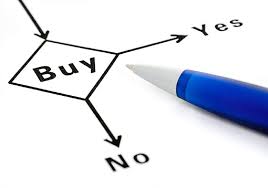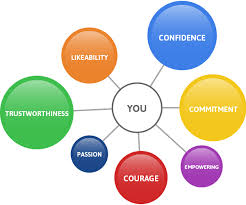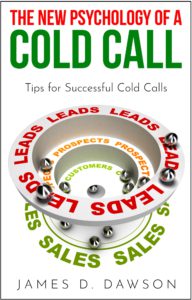The Buying Decision Process
First introduced by John Dewey in 1910, the Buying Decision Process plays a crucial role in understanding your customer’s journey towards buying your products. If you know ‘the road’ that your target customers take in order to formulate their buying decision, then you are more likely to have a positive turnout during a cold call. What are these steps?
Step 1. Need Or Problem Recognition
Purchases are results. They are responses to perceived needs by the customer. In essence, there can never be a purchase without a perceived need. Now, how do needs materialize?
Just like reactions, needs surface to a customer’s consciousness in response to a trigger. That trigger can be caused by internal stimuli, external stimuli, or both. Let’s take a look at some sample scenarios and follow them closely as each of our heroes move through the process.
Scenario 1:
It’s Friday, and a certain woman has many errands to run. She spends the good half of the day processing some documents from one office to another. She decides to skip lunch in favor of a light snack because she needs to meet a client in order to close a deal. By three o-clock, she feels hungry.
Scenario 2:
A man is the best man in his best friend’s wedding. He resides in the US but his best friend lives in the UK. The best man knew he had to go because his best friend traveled all the way from the UK when the former got married three years ago. His budget is tight but he stands 6’2’ so he knew that finding an airplane seat that won’t make him miserable would be a problem.
Scenario 3:
A gamer contemplates buying the recent version of Assassin’s Creed game which is on sale for a week. But he knew that a new World of Warcraft game is going to be released in three months. He can choose only one because that’s what he can afford. Should he wait or not?
Scenario 1 represents a need triggered by an internal stimulus; scenario 2 represents a need triggered by an external stimulus; and Scenario 3 is triggered by both stimuli. Let’s follow them closely and see how they can potentially make a buying decision.
[CLICK HERE: The New Psychology of a Cold Call: Tips for Successful Cold Calls]
Step 2. Information Search
Having recognized a need, the heroes in our scenarios will now have to engage in the second step: information search. Seeking for information is the normal step that we take when we are confronted with a problem and we do so in order to find a solution.
When we seek for information, our options are unlimited. With the presence of the Internet, we can add search engines to our options on top of the traditional sources of information that we know.
But you also have to understand that when a problem is recognized, not everyone immediately springs into action. In some instances, people wait until they feel that seeking for a solution is a priority. This means that moving to this step is a function of time and urgency.
In our scenarios, the first one dictates a problem that needs to be solved at the soonest possible time. Hunger cannot be resolved until after five days. The second one entails that a solution has to be arrived at before the wedding date. And the third entails that a solution is needed before the sale ends. So in terms of searching for information, here’s what our heroes will likely do when searching for information:
Scenario 1:
The woman may search for nearby diners in her area. She may do so by looking at the display advertisements around her, by going online and consulting Google Maps, by using an app such as Foursquare, or by asking around.
Scenario 2:
The best man may ask for recommendations from the people he knows like his brother. And then, he may supplement his search by using websites such as Expedia. Further, he may choose to check the websites of different airlines. And he may look for ticketing agencies to help out.
Scenario 3:
Technically, the gamer doesn’t have to look anywhere else except within himself in order to decide which game to buy. So he simply decides to read about information about both games to get started.
Step 3. Evaluation Of Alternatives
When our heroes have obtained enough information in order to help solve their problems, they are ready to move to the next step: evaluation of alternatives. This step is crucial  because it dictates the outcome of the fourth step.
because it dictates the outcome of the fourth step.
Now, it is rare for a customer to decide to buy two similar products from two different sources. Most only choose one and the best one. That is, whichever product offers the best solution to their problem, that’s what they end up buying.
In our scenarios, it would be impossible for the woman to eat at two diners at the same time. Our best man can’t be in two airlines at the same time. Our gamer, however, can purchase both games – if he can. Note that his budget only affords him to buy one game.
This tells you that when customers evaluate the alternatives they have, they consider a lot of things but will mostly think about their current circumstances. So we can assume that our heroes have now settled to the fact of their current situation and must move to focus their evaluation on the products before them.
Scenario 1:
The woman may find two or three diners next to each other. All of the diners serve what she wants. But hungry as she is, she wants to have the most delicious meal. So in order to help her decide, she scans the menu offered by each diner, she checks on the number of diners currently in-store, and she goes online to read the reviews on each one.
Scenario 2:
The best man, having collected information about airfare rates from multiple airlines, now has to decide based on which will benefit him best. His brother remarks that Airline A has more leg room in its Economy Class than Airline B. However, Airline B is cheaper. Airline C is also a consideration because it offers more luggage allowance on top of an affordable airfare.
Scenario 3:
The gamer has been reading reviews about both online games. He knows the positive and negative comments about Assassin’s Creed and he’s quite fine with the latter. However, there are tons of positive stuff about the upcoming World of Warcraft game. The catch is: no one has actually tried it. All reviews came from beta game testers.
Step 4. Purchase Decision
From Step 3, you understand that after considering their present capabilities or circumstances, our heroes will now focus on product attributes and related information in order to evaluate and make a choice. At this point, let’s see how our heroes may have arrived at their final buying decision.
Scenario 1:
The customer, having discovered that her order is being offered on all three diners, decided to read reviews. In fact Diner C has to best set of reviews so far. But she also believes that the more the customers, the better the food and the service. Diner B has the most diners at that time. She chose Diner B.
Scenario 2:
The best man, considering his budget, has narrowed his options to Airlines A and B. He decided that he didn’t need an extra luggage allowance. He just needed a comfortable economy class seat for his trip. Because of his height, he decided to book with Airline A.
Scenario 3:
The gamer thought that while World of Warcraft has promising reviews, it is still untried in the wider gaming community. He was impressed by the previous installment of the game, but this new one needs to prove itself. He decides to purchase Assassin’s Creed knowing that he did it for a discount and that World of Warcraft may be offered at a cheaper price in the future.
Now, you’re thinking: are those decisions absolute outcomes? The answer is no. Majority of our decisions are influenced by our subjective realities and that we, sometimes, ignore objective information. In the end, what makes our buying decision worthwhile or worthless is the quality of our experience with a product or service once we complete the purchase.
- Post-Purchase Behavior
This final step is where customers find themselves after they’ve made the decision to purchase. And just like the purchase decision stage, this stage is highly subjective. That’s because we have individual standards when it comes to qualifying our experiences.
So all of our heroes may be extremely satisfied, satisfied, neutral, dissatisfied, or extremely dissatisfied with their decisions. What influences the quality of customer experience is the set of expectations that they have with a product or service.
For example, the woman may have expected that because Diner B has the most customers, they have the most delicious food among the three. However, she regretted going there instead of Diner C upon realizing that the number of diners in Diner B is only a coincidence.
Regardless of the quality of experience, post-purchase behavior effectively sets the tone for the succeeding transactions that customers will have on a product, a service, a company, or a brand. If customers report a positive experience, they may record repeat transactions. In doing so, their information search and evaluation of alternatives will be easier and quicker.
They may also become brand ambassadors as they talk to people they know about their experience. However, the same isn’t true for dissatisfied customers. The next time they make a purchase, they may not even consider the disappointing brand as they search for information and evaluate alternatives.
Worse, they may share the negative experience with the people they know, as is the case nowadays, on social media. The stories about companies who came under fire because of negative reviews continue to grow. Just look it up.
The point is, customers talk. And the quality of their narrative is directly proportional to the difficulty they’ve gone through before the purchase decision stage and the quality of experience they have received after the purchase.
So where do sales persons sit in this journey? In all of them. That’s because you may not have an idea about where your prospect is in the buying decision process at the time when you make the call.
Still, you might be thinking: if cold calling can help a prospect make a decision, how come it’s developed some kind of a stigma? We’re answering this question towards the end of the next chapter. But first, let’s take a look at some of the myths associated with cold calling.

Recent Comments